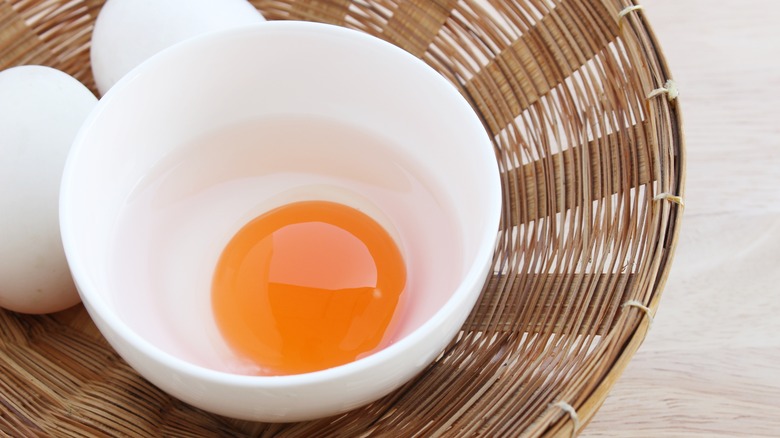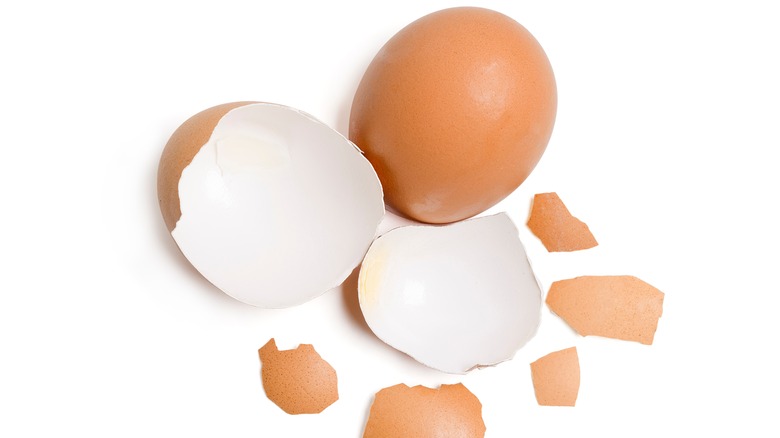Rachael Ray's Genius Tip To Keep Eggshells Out Of Your Food
The fun of cracking eggs to prepare breakfast, make baked goods, or whip up a loaf of bread can wear off after a few dozen tries (or after we reach a certain age). As we get older, the thrill is often replaced by worrying about the potential health risks associated with spreading raw eggs on your hands and kitchen surfaces, as well as the messy and tedious task of fishing for eggshells if you crack one too forcefully.
Even the pros aren't immune to the occasional eggshell fragments, leaving celebrity chef Rachael Ray to come up with an impressive trick to avoid this circumstance. She cracks her eggs in a separate small bowl or ramekin before adding the whites and yolks to a mixing bowl filled with the other ingredients. This way, she can easily find any rogue shell pieces before seamlessly adding eggs to her recipe.
Another good tip — if you are needing multiple eggs for a recipe, crack and blend each one separately before moving on to another since it's more convenient to see and grab the shells when you aren't wrist-deep in the batter bowl (and, it's easier to incorporate eggs into a smooth batter one at a time). It's also helpful to use a clear bowl or dish so you can examine the bottom to ensure you've gotten all the unwelcome pieces.
How to properly crack an egg
Whatever your preferred method is, eggs should always be cracked at the equator, or in the middle, which is its widest and weakest point. But beyond that, there are a couple best ways to crack an egg.
Though the most common practice is tapping it on the rim of a bowl, that's not ideal since doing so can cause tiny fractures in the shell that will cave in when you separate it with your thumbs and create a greater chance for shards of shell to enter the bowl.
Using a flat surface, like the countertop, is a better idea. It may leave a small puddle of egg whites behind, but there won't be as much of a chance for eggshells in the bowl to hunt for afterwards. The trick is to crack the egg with one decisive, firm hit without shattering it and making a mess. Ideally, the egg will crack in one jagged line. Repeated light taps, on the other hand, make too many fracture lines increasing the chances of getting eggshells in the dish.
If you are cracking more than one egg, some bakers even recommend breaking them against each other. Since an eggshell is a softer surface than a bowl's rim or a countertop, it's a gentler and cleaner way of getting at the white and yolk with fewer fractures. And, the countertop should remain clean if you're cracking them over a bowl.
How to easily remove unwanted eggshell pieces
Even the most skilled baker will have to dig small shell fragments out of their dish occasionally, regardless of brute force, since all eggshells are not created equal. Some are more brittle and prone to easily cracking due to factors like the hen's diet, age, and the time of day she laid the egg.
Despite your impulse, there are better retrieval methods than using your fingers. Fingers repel the pieces of eggshells (as do spoons and forks). A better idea is using another, larger piece of shell to act like a magnet. Pick out unwanted pieces by scooping them out with the empty eggshell half. The sharp edges easily pierce the shards without pushing the fragments away, allowing you to trap the unwanted pieces within the natural curve.
To clean up spilled eggs and sanitize kitchen surfaces, cover the mess with inexpensive table salt, and use a paper towel to wipe it all up. This contains the mess, and prevents pushing the egg all over the counter or contaminating a sponge in the process. Throw away the towel and follow up with wiping the surface with a disinfectant spray.



